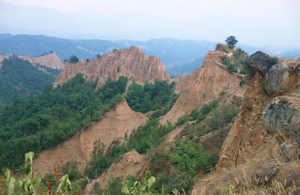 Bulgaria, Natural Phenomena, Melnik
Bulgaria, Natural Phenomena, Melnik
The Sandstones of Melnik
It is in the south-western part of the Pirin Mountains that you will find the Melnik pyramids-sheer, strangely shaped sand and limestone rocks. Melnik, one of Bulgaria's smallest towns, is located right amidst this fantastic scenery.
A border settlement during the Early Middle Ages, the town found itself on the different sides of the Bulgarian-Byzantine border at different times.
Between 1205 and 1229 the feudal lord Alexi Slav - the ruler of Southwest Bulgaria, made Melnik its capital, but by the mid-13th century the town was subjected to Byzantine rule. Even today the ruins of the 13th century Boyar's House form part and parcel of Melnik's silhouette.
During the 17th-18th century the production of gold leaved tobacco and strong red wine turned Melnik into a flourishing merchant town whose fame spread even to such traditional wine producing countries as France, Spain, Italy and Austria.
Its population started building houses on a grand scale atop the foundations of destroyed medieval buildings. Construction centered closely along the banks of the river and its two tributaries flowing into it in the town's center. From here the houses move theatrically upwards along the rocky slopes.
The lower floors are high, the top floors lightly structured, with brought forward eaves and two rows of windows in most cases.
Besides being enhanced, inside lighting thus also gains an artistic impact, while the exterior appears much more impressive, creating an illusion of more floors. The main entrance leads into the traditional salon around which the various living and household quarters are grouped.
One corner is taken up by a glassed terrace and transformed into a balcony in later years. Small corridors lead from the salon to the rest of the rooms, equipped with small windows letting in additional light and replacing the medieval embrasures. Rounded fireplaces extending into chimneys (part of both the interior and exterior), stone towers with open verandas on the top floor and the absence of yards are all typical features of the Melnik house. The lower floor contains the cellar where the famous Melnik wine is aged. The cellar itself is entered via an intricate maze of artificial tunnels dug into the rocks.
The Kordopoulov House, built in 1754, belonged to the wine merchant Manolis Kordopoulis, famous throughout Europe. Two of its four stories are made of stone. Seven inner staircases link the various floors and garret rooms. The salon is lit by the light of 24 windows arranged in two rows. The upper row is made of colored Venetian glass softly filtering the light onto the painted walls, carved ceilings and cupboards. Low window-seats run along three walls, and the wooden floors are covered with colorful rugs. The corner canopy is made in the expensive fabrics. In the big maze for wine you can see lots of enormous tunes.
The Pashovata House, built in 1815, is another impressive example of local architecture with its two stories and garret rooms. A large salon forms the center of the living area, surrounded by 8 rooms and a bathroom. Carved ceilings, marble fireplaces and richly decorated cupboards characterize the interior.
Of the five National Revival period churches preserved in Melnik, the St. Nikolai - The Miracle-Worker (1756) is the most significant one. In all likelihood the same master who constructed the Kordopoulov House built it.
Although painted by an unknown master, the church murals and icons are artistically valuable.
Just as suddenly as Melnik appears amidst the natural, inaccessible fortress of the Sandstone Pyramids, just as unexpectedly does it reveal its wealth.


